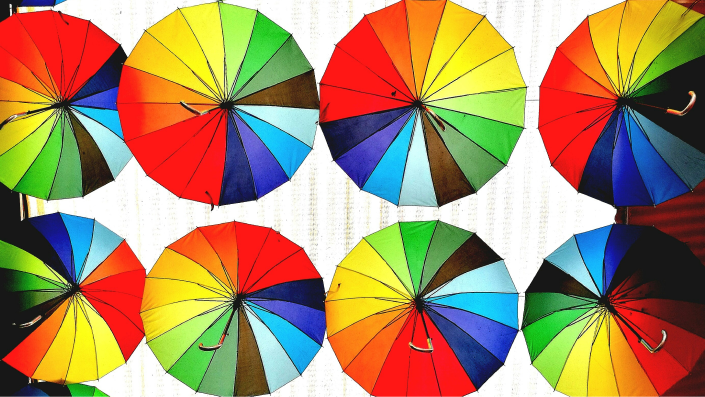
In Brief
Have you ever noticed how certain colors can instantly shift your mood? The vibrant yellow of sunflowers might spark joy, while the deep blue of an evening sky brings calm. This isn't just coincidence – a strong connection exists between color and our emotional states.
Throughout history, cultures across the globe have recognized color's significant impact on human well-being. From ancient healing temples to modern therapeutic spaces, color plays a key role in promoting balance and restoration. Today, interest in these traditional approaches is growing again.
As mental health professionals look for new ways to support their clients, many are exploring complementary methods that enhance standard therapy. Color-based interventions offer interesting possibilities for creating more holistic treatment experiences. Let's see how this ancient practice is gaining new relevance in modern mental health settings.
What Is Color Therapy?
Color therapy, or chromotherapy, is a complementary healing method that is neither evidence-based nor a form of psychotherapy. It uses color and light to balance emotional and physical well-being. Rather than replacing traditional therapeutic approaches, it works alongside them to create a complete treatment experience. The practice relies on the idea that different colors carry specific wavelengths and energies that can influence our psychological and physiological states.
The roots of color therapy stretch back thousands of years to ancient civilizations in Egypt, India, and China. Egyptian healing temples featured colored glass windows that bathed patients in therapeutic light. In India, Ayurvedic medicine included color in its holistic healing system. Chinese medicine linked different colors to specific organs and energy pathways.
In recent decades, interest in color therapy has surged within holistic and integrative mental health approaches. Modern practitioners blend ancient wisdom with contemporary understanding of neuroscience and psychology. This combination has led to more sophisticated applications that complement evidence-based therapeutic methods.
Today's therapeutic environments use color therapy in various ways, from carefully designed treatment spaces to specific color-based interventions. Therapists might use colored lighting, visualization exercises, or thoughtfully chosen decor to support treatment goals. Some practitioners incorporate color breathing exercises, while others use color cards or digital tools to help clients explore their emotional responses to different hues.

The Psychology of Color: How Colors Influence Mood and Behavior
Colors have a significant impact on our emotions and behavior through complex psychological and physiological processes. Specific colors trigger predictable emotional responses, making them effective tools in therapeutic settings.
Common color-emotion associations include:
- Blue: Encourages calmness and improved focus. Blue environments are associated with mood states that lead to lower heart rate and blood pressure, making it suitable for managing anxiety.
- Red: Increases energy, passion, and alertness while boosting arousal. This color can enhance motivation but may also increase agitation in some people.
- Yellow: Inspires optimism and creativity, though too much exposure can unexpectedly increase anxiety. Small amounts are best for lifting mood.
- Green: Promotes balance and renewal, often linked with nature and growth. Green settings aid emotional regulation and stress relief.
The neuroscience of color perception suggests meaningful links between how we process visual information and how we experience emotions. When we see different colors, light enters the eye and sets off a chain of neural responses that not only allow us to perceive color but can also influence mood and overall physiological state. Color and light exposure play a role in emotional regulation, which may help explain why certain colors feel calming while others feel energizing.
Methods and Modalities in Color Therapy
Modern color therapy uses various techniques ranging from direct light exposure to subtle changes in the environment. Each method provides unique benefits and can be tailored to fit individual client needs and treatment goals.
Visualization and guided imagery using color offer a strong internal approach. Therapists guide clients through exercises where they imagine breathing in specific colors or visualizing colored light flowing through their body. This technique works particularly well for clients who respond strongly to mental imagery and can be practiced independently between sessions.
Colored art materials in art therapy sessions provide tactile engagement with color. Clients select and work with materials that resonate with their emotional state, using:
- Colored pencils and pastels: Allow precise control and layering
- Watercolors: Enable fluid expression and color blending
- Collage materials: Provide pre-existing color choices for exploration
Environmental design creates an immersive therapeutic atmosphere. Research suggests optimal choices include:
- Soft blues and greens: Promote relaxation and reduce anxiety
- Warm neutrals: Create safety without overwhelming
- Natural light enhancement: Boosts mood and supports circadian rhythms
- Accent colors: Add subtle interest while maintaining calm
These methods can be combined or used individually, depending on client preferences and therapeutic goals.

Clinical Applications in Mental Health Settings
Color therapy finds diverse uses across mental health challenges, offering gentle yet effective support for various client populations. When dealing with anxiety and depression, specific color interventions can help stabilize emotional states and physiological responses.
For children and nonverbal clients, color therapy provides an accessible way to communicate. Young clients naturally choose colors that mirror their internal states, making color selection a useful assessment tool. Art-based color activities allow for emotional expression when words fall short, particularly beneficial for:
- Pre-verbal children: Indicating mood states through color choices
- Autism spectrum clients: Engaging with preferred color patterns
- Selective mutism: Expressing emotions through color cards or drawings
Trauma recovery benefits from color therapy's gentle approach to nervous system regulation. Soft greens and blues can activate the parasympathetic nervous system, helping clients transition from hyperarousal to calm states. Therapists have seen success using color breathing exercises where clients visualize inhaling soothing colors during grounding work.
Pairing with mindfulness and somatic practices enhances the effectiveness of color therapy. Practitioners combine color visualization with body scanning, asking clients to imagine healing colors flowing to areas of tension. Movement therapies use colored scarves or lighting to heighten somatic awareness. These integrative methods create multi-sensory experiences that anchor therapeutic insights and support lasting change.

Ethical and Cultural Considerations
Working with color therapy involves careful attention to cultural context and individual experiences. What brings comfort to one client might trigger distress in another, making cultural competence vital for ethical practice.
Cultural symbolism varies dramatically across backgrounds:
- White: Represents purity in Western contexts, but signifies mourning in many Asian cultures
- Red: Symbolizes good fortune in Chinese traditions, yet indicates mourning in South Africa
- Green: While calming for many, it represents conflict in parts ofIndonesia
- Black: Denotes sophistication in the West but can represent divine connotations, mystery, and concealed wisdom in Chinese culture
Individual preferences and triggers need equal consideration. A client's personal history with color—perhaps yellow walls in a childhood trauma setting—takes precedence over any general therapeutic application. Always explore color associations during intake and remain flexible in your approach.
Informed consent requires clear communication about:
- The complementary nature of color therapy
- Limited scientific evidence for standalone treatment
- Your training and experience level with color-based interventions
- Alternative evidence-based options available
Most importantly, never present color therapy as a replacement for established treatments, especially for serious mental health conditions. Severe depression, psychosis, or trauma-related disorders require evidence-based primary interventions. Color therapy works best as an addition to proven therapeutic methods, enhancing rather than replacing comprehensive care.
Ethical practice means acknowledging both the benefits and limitations of color therapy while respecting each client's unique cultural perspective and personal experiences with color.
Integrating Color Therapy into Your Practice
Getting started with color therapy doesn’t demand large investments or extensive training. Simple changes to your therapy room can have an immediate effect—replace harsh fluorescent lighting with warm-toned bulbs, add plants for natural green elements, or introduce soft blue accents through artwork or textiles. Art-based interventions offer another easy way to begin: keep colored pencils, markers, or paint available for clients to express emotions visually when words seem inadequate.
Working together with clients is important when choosing emotionally supportive color palettes. During intake, discuss clients' color associations and preferences. Some may find deep blues calming while others feel energized by warm oranges. Make a note of these preferences and adjust your space or materials as needed. This collaborative approach empowers clients and shows your dedication to personalized care.
Group therapy applications include:
- Color journaling: Members use colored materials to express feelings, with each hue representing different emotions
- Body mapping: Participants color silhouettes to indicate emotional "hot spots" and add calming imagery
- Color meditation: Guided visualization focusing on specific colors for relaxation or energy
Child therapy naturally includes color through play materials, emotion wheels, and creative activities. Young clients often communicate more freely through color choices than verbal expression.
For a deeper understanding, consider specialized training through:
- Art therapy programs: Many include color psychology modules
- Continuing education workshops: Focus on evidence-based color applications
While formal certification isn't necessary for basic color integration, additional training can improve your ability to use color therapeutically and ethically within your existing practice framework.

Key Takeaways
Color therapy provides a gentle, non-invasive way to support emotional regulation and expression. Its accessibility makes it beneficial for various client groups, from children who have difficulty expressing themselves verbally to adults looking for methods to manage stress and anxiety. The practice is particularly effective when thoughtfully integrated into existing therapeutic frameworks.
Though the research is still developing, color can complement other therapeutic practices. Studies show positive effects when color therapy supplements evidence-based treatments, particularly for:
- Managing anxiety: Blue and green environments help reduce physiological stress markers.
- Enhancing mood: Warm colors can combat lethargy and increase energy levels.
- Integrating mindfulness: Color visualization can deepen meditation experiences and enhance present-moment awareness.
Therapists should adopt culturally sensitive, client-centered approaches. Keep in mind that color meanings can vary significantly across cultures—what calms one client might upset another. It's important to explore individual color associations during intake and stay adaptable in your applications.
Incorporating color therapy can be as simple as making changes to your environment or using color in mindfulness exercises. Begin with:
- Environmental adjustments: Replace harsh lighting with warm bulbs.
- Art supplies: Provide colored materials for creative expression.
- Guided imagery: Incorporate color breathing in relaxation exercises.
Remember, color interventions should complement—not replace—evidence-based clinical methods. Color therapy works best as an additional approach that enhances traditional treatments. This balanced perspective ensures ethical practice while offering creative therapeutic options for clients seeking holistic care.

How Blueprint can help streamline your workflow
Blueprint is a HIPAA-compliant AI Assistant built with therapists, for the way therapists work. Trusted by over 50,000 clinicians, Blueprint automates progress notes, drafts smart treatment plans, and surfaces actionable insights before, during, and after every client session. That means saving about 5-10 hours each week — so you have more time to focus on what matters most to you.
Try your first five sessions of Blueprint for free. No credit card required, with a 60-day money-back guarantee.























